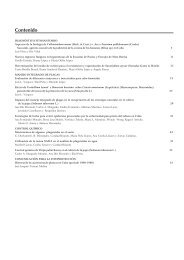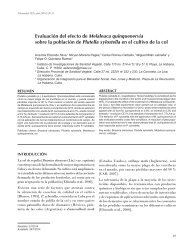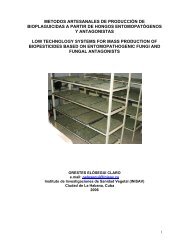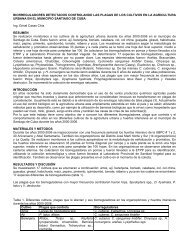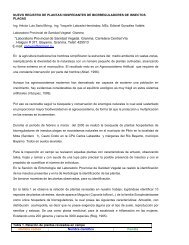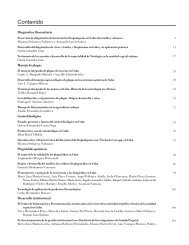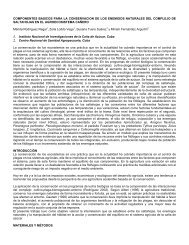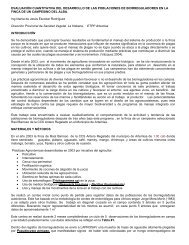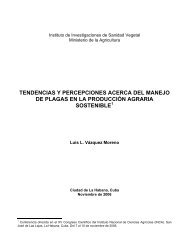2 - Instituto de Investigaciones de Sanidad Vegetal
2 - Instituto de Investigaciones de Sanidad Vegetal
2 - Instituto de Investigaciones de Sanidad Vegetal
You also want an ePaper? Increase the reach of your titles
YUMPU automatically turns print PDFs into web optimized ePapers that Google loves.
Combate <strong>de</strong> Acromyrmex octospinosus...<br />
hongo B. bassiana, comprobada por los insectos micosados<br />
y la apertura <strong>de</strong> los bibijagüeros. (Tabla 1).<br />
La efectividad <strong>de</strong> Bibisav-2 sobre A. octospinosus a los<br />
treinta días postratamiento alcanzó el 97% sin dife-<br />
Tabla 1. Efectividad técnica (%) <strong>de</strong>l bioplaguicida Bibisav-2 en el combate <strong>de</strong> Acromyrmex octospinosus<br />
(Reich) (octubre 1997-enero 1998)<br />
Variantes<br />
Efectividad técnica (%)<br />
7 días 15 días 30 días 60 días 90 días<br />
Bibisav-2 47,0 a 67,0 b 97,0 a 100,0 a 100,0 a<br />
Do<strong>de</strong>cacloro 32,0 a 89,0 a 100,0 a 100,0 a 100,0 a<br />
Testigo 0 0 0 0 0<br />
rencias significativas con el estándar Mirex <strong>de</strong> reconocida<br />
eficacia sobre dicha especie (Tabla 2).<br />
Resultados similares fueron obtenidos en las investigaciones<br />
realizadas por Trujillo (1998) con tratamientos<br />
<strong>de</strong> B. bassiana para el combate <strong>de</strong> A. insularis, los cuales<br />
provocaron la infección sobre las poblaciones <strong>de</strong> A. insularis<br />
y la muerte <strong>de</strong>l bibijagüero a partir <strong>de</strong> los treinta<br />
días postratamiento.<br />
En Brazil, Diehl-Fleig y Lucchese (1991) indicaron que<br />
la aplicación <strong>de</strong> B. bassiana y M. anisopliae provocaron<br />
mortalidad sobre las especies <strong>de</strong> Acromyrmex striatus, lo<br />
que coinci<strong>de</strong> con los resultados obtenidos en esta experiencia<br />
sobre la especie A. octospinosus.<br />
Por otra parte, Alves y Sosa (1983) realizaron estudios<br />
sobre la susceptibilidad <strong>de</strong> los soldados y obreras <strong>de</strong><br />
Atta rubropilosa, e indicaron que los soldados <strong>de</strong> esta especie<br />
son más sensibles frente a B. bassiana, mientras<br />
que las obreras lo son frente a M. anisopliae.<br />
A los noventa días <strong>de</strong> aplicado Bibisav-2 no se observaron<br />
agujeros activos ni áreas con actividad <strong>de</strong> estos insectos,<br />
al igual que don<strong>de</strong> se aplicó el formicida Mirex,<br />
mientras que el número promedio <strong>de</strong> agujeros activos<br />
en las áreas testigos aumentó <strong>de</strong> 3,7 a 6,5, y el área<br />
Tabla 3. Caracterización <strong>de</strong> los bibijagüeros <strong>de</strong> Acromyrmex octospinosus bajo tratamiento con Bibisav-2<br />
(octubre 1997-enero 1998)<br />
Variantes<br />
Bibisav-2<br />
No. <strong>de</strong><br />
bibijagüeros<br />
Estado inicial<br />
Estado final<br />
No. agujeros Área (m 2 ) No. agujeros Área (m 2 )<br />
1 4 16 0 0<br />
2 3 8 0 0<br />
3 2 6 0 0<br />
4 3 20 0 0<br />
Total (x) /////////////////// 3 12,5 0 0<br />
Do<strong>de</strong>cacloro<br />
1 4 20 0 0<br />
2 4 10 0 0<br />
3 3 15 0 0<br />
4 2 7 0 0<br />
Total (x) ////////////////// 3,25 13,0 0 0<br />
Testigo sin<br />
tratamiento<br />
1 5 35 7 49<br />
2 3 10 6 12<br />
3 4 5 8 6<br />
4 3 7 5 8<br />
Total (x) /////////////////// 3,7 14,25 6,5 18,75<br />
fitosanidad/43



